最新初中英语语法 不定代词 讲义复习课程
- 格式:doc
- 大小:78.50 KB
- 文档页数:6


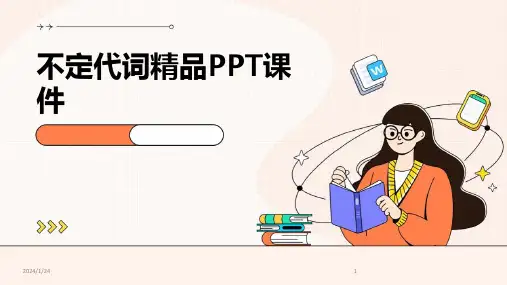
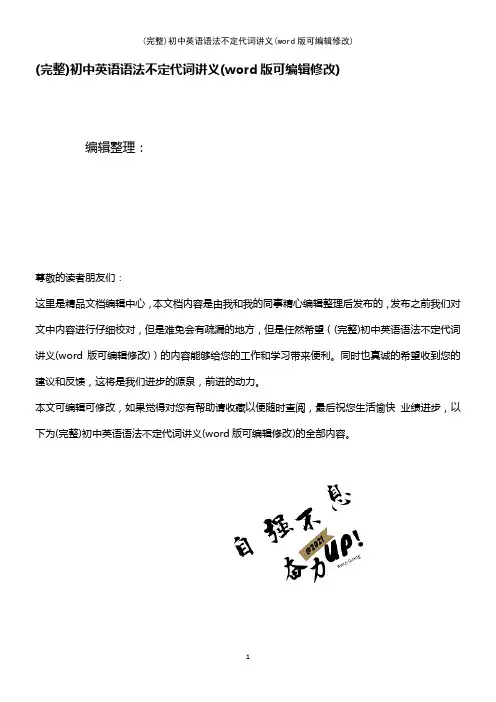
(完整)初中英语语法不定代词讲义(word版可编辑修改)编辑整理:尊敬的读者朋友们:这里是精品文档编辑中心,本文档内容是由我和我的同事精心编辑整理后发布的,发布之前我们对文中内容进行仔细校对,但是难免会有疏漏的地方,但是任然希望((完整)初中英语语法不定代词讲义(word版可编辑修改))的内容能够给您的工作和学习带来便利。
同时也真诚的希望收到您的建议和反馈,这将是我们进步的源泉,前进的动力。
本文可编辑可修改,如果觉得对您有帮助请收藏以便随时查阅,最后祝您生活愉快业绩进步,以下为(完整)初中英语语法不定代词讲义(word版可编辑修改)的全部内容。
不定代词一、不定代词的定义:不指明代替任何特定名词或形容词的代词叫做不定代词。
不定代词在句中可以作主语、宾语、表语或定语等。
不定代词可以分为一般不定代词和复合不定代词.二、一般不定代词及用法1. some/any 含义:“一些”,既可以修饰可数名词,也可以修饰不可数名词。
区别:1)。
some用于陈肯句;any用于疑问句或否定句。
I can see some flowers, but I can`t see any apples。
2)。
some 用在疑问句中有表示请求或建议的功能;any用在肯定句中有强调或加强语气的功能,意为“任何”。
Would you like some coffee?You may come at any time.2. many/much注意:“many”和“much”前可有so, too等词进行修饰。
There are too many mistakes in your diary。
So many people are waiting for the bus.Sorry, I’m afraid I can't go with you. I've got too much work to do.3。
few/a few/little/a littleHe has a few friends.他有几个朋友。
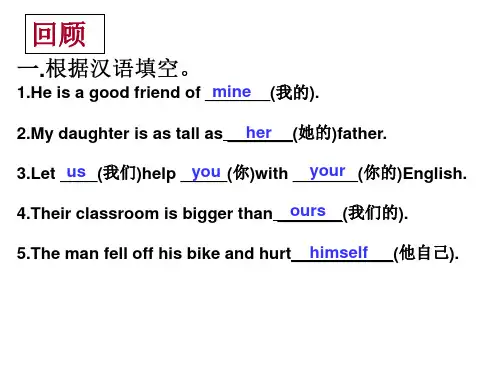

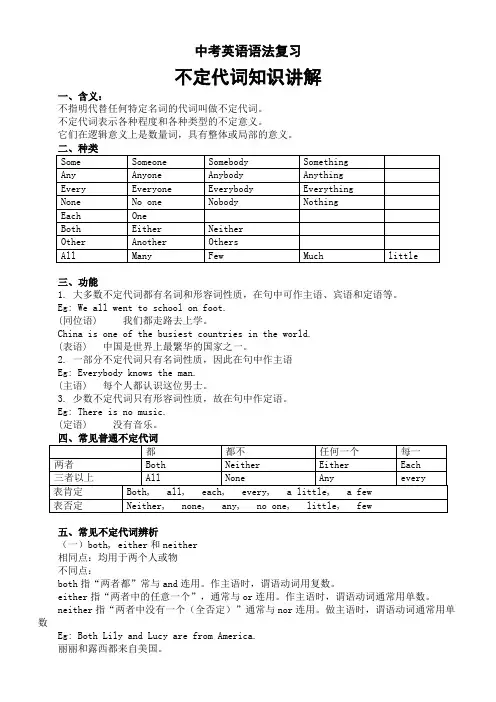
中考英语语法复习不定代词知识讲解Either tea or coffee is OK.或者茶或者咖啡都可以。
Neither tea nor coffee is OK.茶和咖啡都不可以。
(二)All,any与none相同点:均用于三者或三者以上的人或物不同点:all指“三者或三者以上的人或物的全部”作主语时,谓语动词用复数。
any指“三者或三者以上的人或物的任意一个”,只能作定语。
none指“三者或三者以上的人或物中没有一个(全否定)”相当于not anyEg: All of them are from China.他们都来自中国。
You can ask me for any questions.你可以问我任何问题。
None of us knew how to treat her.我们没有人知道如何对待她。
(三)each与every相同点:“each/every + 名词”作主语时,谓语动词要用单数形式不同点:each用作形容词或代词,可单独使用;强调个体;指两者或两者以上的人或事物中的“每一个”;后可加of短语every仅用作定语,不可单独使用;强调整体;指三者或三者以上的人或事物中的“每一个”;后不可加of短语Eg: Every student in the class passed the exam.班里每个学生都通过了考试。
She gave each child a present.她给每个孩子一份礼物。
(四)some与any相同点:均可修饰可数名词和不可数名词,表示“一些”,即表不确定的数量。
不同点:some 一般用于肯定句中,也可用于表示建议或请求的疑问句中,表示说话人希望得到肯定的回答。
any多用于疑问句、否定句或条件句中,用于肯定句中时表示“任何(一个人/一些)Eg: There are some books on the desk.桌子上有一些书。
There aren’t any books on the desk.桌子上没有书。
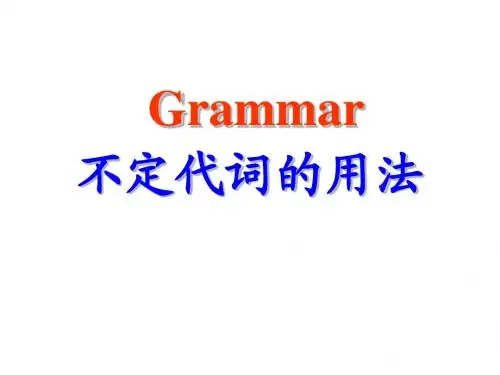
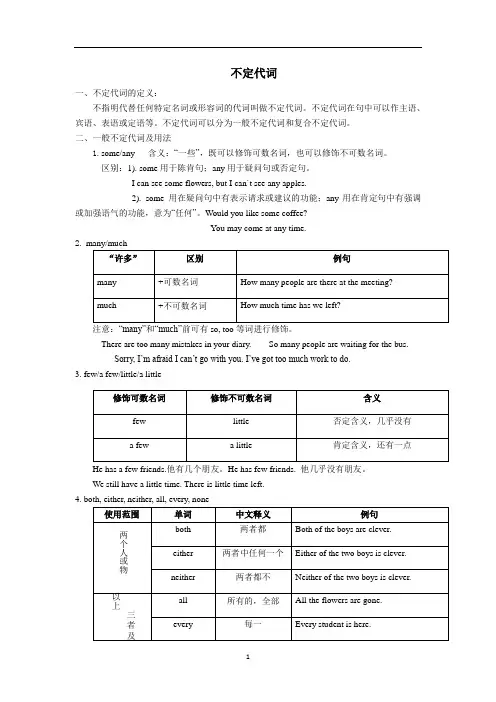
不定代词一、不定代词的定义:不指明代替任何特定名词或形容词的代词叫做不定代词。
不定代词在句中可以作主语、宾语、表语或定语等。
不定代词可以分为一般不定代词和复合不定代词。
二、一般不定代词及用法1. some/any 含义:“一些”,既可以修饰可数名词,也可以修饰不可数名词。
区别:1). some用于陈肯句;any用于疑问句或否定句。
I can see some flowers, but I can`t see any apples.2). some 用在疑问句中有表示请求或建议的功能;any用在肯定句中有强调或加强语气的功能,意为“任何”。
Would you like some coffee?You may come at any time.2. many/much注意:“many”和“much”前可有so, too等词进行修饰。
There are too many mistakes in your diary. So many people are waiting for the bus.Sorry, I’m afraid I can’t go with you. I’ve got too much work to do.3. few/a few/little/a littleHe has a few friends.他有几个朋友。
He has few friends. 他几乎没有朋友。
We still have a little time. There is little time left.4. both, either, neither, all, every, none5. “other” 、“another”、“others”和“the others”I have two pencils. One is yellow, the other is red.I don’t like this green pencil, please give me another one.In our class, some students like playing football, others like playing basketball.There are seven people in Running Man. One is a woman, and the others are men.三、复合不定代词及用法1. 复合不定代词的构成:复合不定代词是由some-,any-,no-,every-加上-one,-body,-thing 所组成的不定代词。
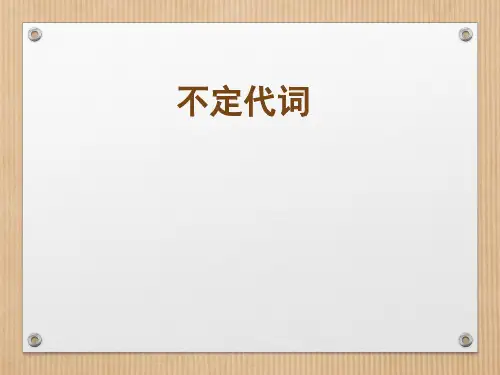

中考语法专项复习不定代词4. the other, another如,There are ten students here.Where are the others?Some people like sports. Others like reading.5. few / a few little/a little否定肯定加可数名词few a few加不可数名词little a little如You have few friends, have you?二、复合不定代词/副词指人指物指地点Some(肯定某个)Someone/body某人Something某物、某事Somewhere某地某个地方Any (否定句/疑问句任何的) Anybody/ one任何人Anything任何事Anywhere任何地方Every (每个的)Everybody/one每个人Everything每件事Everywhere每个地方No(不,没有)Nobody/ no one没有人Nothing什么都没有Nowhere不在某处,没有什么地方注意:1复合不定代词或副词的修饰词应放其后而不要放在其前面。
2不定代词应被看作单数,即使用and连接两个不定代词,也要看作单数,如:Anyone and everyone has the right. 任何人,每一个人都有这样的权力。
即时训练一、用the other, another, neither, both , a11 ,none 填空1. If the question is answered incorrectly, _____ question will be given to you2.—Which would you like to drink, coffee or orange juice?— . Please give me a cup of tea.3. —Where would you like to go, Jinan or Qufu?— . I only want to go to Qingdao.4. Sam looks like his Dad. They are ______ tall.5. Which of the two Tshirts will you take?I’ll take ______, one of my brother, the other for myself.6.What do you usually do in your spare time, playing the violin or the piano?I do ___________of them.I practice singing with some volunteers. 7—How heavily it rained this early morning.—Yes. But of the students in our class was late for school.8. –Would you like some coffee or tea?–I don’t mind. ________ is OK.9. The books are so nice, which one can I take?— Oh, you can take _________ of them. I’ll keep none.10. My sister has two skirts. One is yellow, _______ is black.二、单项选择1. –Mum, can I have something________?–Oh, dear. You can only drink some water. There is________ in the kitchen.A. to drink; nothing elseB. drinking; something elseC. to eat; something elseD. eating; nothing else2. I’m leaving for the exam. Byebye, Mum.Well, make sure you’ve got ______ ready.A. somethingB. anythingC. everythingD. nothing3. How can I make friends in a new school?Say hello to______ to you today,and you can have a friend tomorrow.A.new someone B.someone new C.new anyone4.When I returned to my hometown, I was nearly lost. Almost_______ had changed.A. nothingB. anythingC. somethingD. everything5. —Who helped you clean the classroom yesterday?_______.I cleaned it all by myself.6.—Can I have some more ice cream,Mum?Sorry. There is _______left in the fridge.C.no one7. She is new here, so we know about her.A. nothingB. somethingC. anythingD. everything8.—Oh,you’re reading a newspaper .Is there _______in it?I don’t know. I read it just now.A.new somethingB.anything newC.something new9. There are only_________new words in the passage,but I know ______of them.A.some;allB.a few;noneC.lots of;a fewD.few;none10.—Your tea,please.There must be_______in the tea.I like this kind of tea with sugar.A.nothing sweetB.something sweetC.sweet somethingD.sweet nothing参考答案一、1. another 2。
不定代词
一、不定代词的定义:
不指明代替任何特定名词或形容词的代词叫做不定代词。
不定代词在句中可以作主语、宾语、表语或定语等。
不定代词可以分为一般不定代词和复合不定代词。
二、一般不定代词及用法
1. some/any 含义:“一些”,既可以修饰可数名词,也可以修饰不可数名词。
区别:1). some用于陈肯句;any用于疑问句或否定句。
I can see some flowers, but I can`t see any apples.
2). some 用在疑问句中有表示请求或建议的功能;any用在肯定句中有强调或加强语气的功能,意为“任何”。
Would you like some coffee?
You may come at any time.
2. many/much
注意:“many”和“much”前可有so, too等词进行修饰。
There are too many mistakes in your diary. So many people are waiting for the bus.
Sorry, I’m afraid I can’t go with you. I’ve got too much work to do.
3. few/a few/little/a little
He has a few friends.他有几个朋友。
He has few friends. 他几乎没有朋友。
We still have a little time. There is little time left.
4. both, either, neither, all, every, none
5. “other” 、“another”、“others”和“the others”
I have two pencils. One is yellow, the other is red.
I don’t like this green pencil, please give me another one.
In our class, some students like playing football, others like playing basketball.
There are seven people in Running Man. One is a woman, and the others are men.
三、复合不定代词及用法
1. 复合不定代词的构成:复合不定代词是由some-,any-,no-,every-加上-one,-body,-thing 所组成的不定代词。
注意:形容词或else修饰复合不定代词时,形容词或else要置于复合不定代词之后。
There’s nothing else in the fridge.冰箱里没有其他的东西了。
2. some-类的复合不定代词常用于肯定句或征求意见的疑问句中;any-类的复合不定
代词常用于否定句、疑问句或条件句中。
Someone wants to talk with you. 有人想和你说话。
Can I have something to drink, please? 请问我可以喝点东西吗?
He doesn’t want to do anything. 他不想做任何事情。
3. any-类的复合不定代词与not连用,相当于no-类的复合不定代词。
There is not anything(= nothing) in that box. 那个盒子里没有什么东西。
4. no one可以用于回答who引导的疑问句,不能回答how many引导的疑问句。
---Who knows the answer to the question? 谁知道这个问题的答案。
---No one. 没有人知道。
5. every-类的复合不定代词与not连用,表示部分否定。
Not everybody likes watching TV. 并非人人都喜欢看电视。
Not everything is like what you said. 不是一切都像你说的那样。
6. –one类和-body类的复合不定代词之后可以加上-‘s构成所有格。
He just found someo ne’s wallet.他刚刚发现别人的钱包。
一、重难点
1.在否定句中not...any的意义相当于no。
There isn’t any (= is no) water in the bottle.
2. some用于可数名词单数前,表示“某个”。
Some careless man has taken my umbrella.
某个粗心大意的人拿走了我的雨伞。
3. everyone意为“人人、每人”,只指人,不指物,其后不能跟of短语;every one意为“每个”,可以指人,也可以指物,后面可以跟of短语。
与every搭配的不定代词后,谓语用单数形式。
Everyone in the class passed the math exam.这次数学考试班上人人都及格了。
Every one of us must study hard.我们中每一位都必须努力学习。
二、易错点:
1. 在征求意见的疑问句中或希望得到肯定回答的疑问句中,常用some.
Would you like some dessert? 你要吃些甜点吗?
2. both和all与not连用时表示部分否定,意为“并非......都......”。
如:
Both my parents are not doctors.并非我的父母都是医生。
3. each 表示“每一”,可以跟单数可数名词,也可以单独使用。
each强调个体,可以用于两者之间,可以用于三者或三者以上之间,可以和of连用。
在句中可以作主语、宾语或同位语。
作主语时,谓语动词用单数。
Each student can spend 10yuan.每个学生能花10元钱。
Each of his children goes to a different school. 他的每个孩子都在不同的学校读书。
冠词
冠词是说明名词所表示的人或事物的一种虚词,置于名词之前,它不能离开名词而单独存在。
冠词的分类:不定冠词、定冠词、零冠词。
一、不定冠词
1. 不定冠词的搭配:
不定冠词有a和an两个,表示“一个”,“一类”或“一”,可以说是单数名词的帽子,用于单数名词之前。
2. 不定冠词的用法
3. 不定冠词常用在某些固定词组中,
a lot (of) 许多,大量 a little 一点儿 a few 一些,少数几个
in a hurry 匆忙have a cold 感冒make a face 做鬼脸
a number of许多 a pair of 一对have a good time过得愉快
have a swim=swim have a walk=walk have a look=look
have a talk=talk
二、定冠词
定冠词只包含一个“the”,用在名词的前面,帮助指明名词的含义。
区别于不定冠词,定冠词具有确定的意思,用以特指人或事物。
1. 定冠词的基本用法
2. 定冠词的其他用法
三、零冠词
零冠词是指名词前面没有不定冠词( a/an )、定冠词( the ),也没有其他限定词的现象。
1. 零冠词的基本用法
2. 不用冠词的其他情况
二、易错点:
1. 不定冠词a用在辅音音素前,而不是用在辅音字母前;an用在元音音素前,而不是用在元音字母前。
如:a European, a university, an hour, an honest boy。
2. 零冠词中,国名、人名前不加冠词,是指单纯词形式的词,如:England, America, Frank;不能是合成词,如:the United States of America。
3. 当由介词by加交通工具表达交通方式时,不加冠词(但是由动词take加交通工具时,则需要用冠词),例如:by bus=take a bus; by taxi=take a taxi。